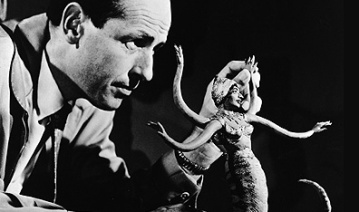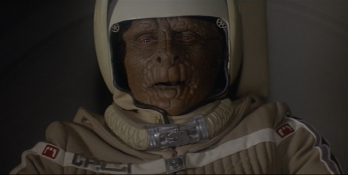Ray Harryhausen Was Born This Day 95 Years Ago
“…You must remember that my type of film is very distinctive from the average special-effects picture… but they really belong in a separate category, which I don’t think many people realize” – Ray Harryhausen.
“It all started with King Kong, of course,” Raymond Frederick “Ray” Harryhausen recalled in one interview. His aunt took the then 13 year old schoolboy to watch the movie in 1933. “I knew it was a ‘gorilla picture,’ but didn’t know anything much about it… I saw that at Grauman’s Chinese [Theater, Hollywood Boulevard] and I haven’t been the same since.”
Like most seven-year-old kids, yours truly – back in the day – lived and breathed dinosaurs, Ancient History and sci-fi. So to find someone like Ray Harryhausen who had not only followed those exact same interests, but lovingly crafted them into his work, was a sheer delight. Some of my most cherished childhood moments involved some of Harryhausen’s most thrilling screen moments.
When he passed away in May 2013, notes for an Obituary were hastily prepared; unfortunately, none were published anywhere.
What better time, what better place, to put them to good use?
^ The Master At Work, plus some of his impressive conceptual artwork
“Ray Harryhausen was a legend, a genius, an artist, a filmmaker, a magician, but more than that he was an inspiration. He showed us the way. He showed us that a grown man could play with monsters and get away with it. How cool is that?” – Rick Baker.
From 1949 – when Willis O’Brien hired him as an assistant on Mighty Joe Young (1949), a poor imitation of King Kong – to 1981 (and since), his menagerie of monsters has thrilled generations. For one thing, the sheer diversity of his work is of particular merit. From his original Ymir: the Venusian alien from 20 Million Miles To Earth (1957) which grows to Kong-like proportions and runs rampant through Rome, to the intricate designs of the alien vessels in Earth vs The Flying Saucers (1956) and the bizarre Selenites in First Men In The Moon (1964) Harryhausen produced some of the most striking science fiction and fantasy films.
His unique creative process is even more remarkable when you consider how paltry the budgets of those movies really were... Even the giant octopus from It Came From Beneath The Sea (1953) destroyed the Golden Gate Bridge with only six tentacles. “We couldn’t afford to make the other two,” was Harryhausen’s amusing excuse.
One Million Years BC (1966) (above); The Valley of Gwangi (1969) (below)
“We both loved King Kong with all of our hearts… I said: I wanna be a writer some day. He said: well maybe some day you’ll write a screenplay for me and I’ll do dinosaurs for you…” – Ray Bradbury.
Ray Harryhausen’s first cinematic foray into prehistoric monsters – and also his first solo screen credit – came in 1953 with The Beast From 20,000 Fathoms, based on a Saturday Evening Post short story by Ray Bradbury. Here, Harryhausen developed his celebrated Dynamation process; his monster: a Rhedosaurus makes for a truly awesome spectacle and the film became a success.
The Hammer remake: One Million Years BC (1966) was a showcase for Harryhausen at the height of his stop-motion prowess. The scenes of the Allosaur attacking Raquel Welch’s tribe, the duel between the Tyrannosaur and the Triceratops and the encounter with the giant turtle on the beach were particularly memorable.
In 1969, along came The Valley of Gwangi – in which cowboys had to fend off dinosaurs in the Forbidden Valley. A rare critical and commercial failure for Harryhausen, it marked the end of his personal association with animated dinosaurs. Harryhausen remarked that “Hollywood is noted for glamourizing the actors, and I tried to glamourize the dinosaur as well.”
“This master craftsman gave unforgettable shape to figures drawn from those depths where the creatures of myth, legend and dream reside in all of us. They have beguiled children for half a century, haunted their memories as grown-ups and influenced generations of special effects artists” – Leonard Nimoy.
Harryhausen is said to have chosen Jason and the Argonauts (1963) as his personal favourite endeavour. Todd Armstrong (apparently dubbed throughout by another actor) had to contend with various mythical creatures, including the Harpies and the Hydra.
Most fans cite the climactic battle with the army of skeletons as the animator’s most accomplished sequence. Yes, its terror lies in its flawless and intricate execution, enhanced dramatically by thumping music from Bernard Hermann. But for me, the moment when Talos suddenly creaks his head around to stare down at Hercules, cuing another fabulous Bernard Hermann score, never fails to induce the goosebumps!
^ The Seventh Voyage of Sinbad (1958)
^ The Golden Voyage of Sinbad (1973)
^ Sinbad and the Eye of the Tiger (1977)
“Seventh Voyage was the first Harryhausen feature to be filmed in Technicolor and Dynamation… Golden Voyage… carries a sense of mystery and wonder quite unlike that of any other fantasy film… The Eye of the Tiger was not the film it might have been…” – Phil Edwards.
A fascinating factor of the Harryhausen portfolio was the trilogy of Sinbad adventures. In 1958, the The Seventh Voyage of Sinbad set the box office alight with its enticing blend of eastern adventure and sensational animated figures: the dragon, the two-headed roc, but it was that horned cyclops that stole every scene. The sensational duel with the skeleton was deemed so frightening, the British Film Censor deleted the scene(!) in order to grant the film a ‘U’ Certificate.
The Golden Voyage of Sinbad (1973) did well to recapture Seventh’s exotic charm. It had an excellent cast and wondrous location photography alongside startling effects. The highlight almost certainly was the battle with the six-armed goddess Kali, one of Harryhausen’s more exciting accomplishments.
Although it had strange bug-eyed bipeds, a troglodyte, even a baboon, Sinbad and the Eye of the Tiger (1977) could not compete with its forebears, critically or commercially. No matter. For me, it was still Harryhausen – i.e. it still held the power to amaze.
“Sinbad was a breakaway from the mad monsters and dinosaurs-on-the-loose…” Harryhausen explained. “That type of inexpensive exploitation picture was very popular in those days… We had to include a lot of destruction and fast movement, or we couldn’t sell the idea to the studio.”
Incidentally, at one point, a “Sinbad on Mars” was mooted. Whatever happened to that?
“It’s in limbo,” the Master sighed.
“He’s great, he’s funny… First, Ray talks you through it. Then he will tell you… how you are going to fight the creature. Then Ray comes in with a big cardboard cutout. He says: ‘This is how big the monster is. This is where the monster is going to go'” – Harry Hamlin.
Clash of the Titans (1981) turned out to be his final – but most ambitious – movie. Incidentally, it would have the largest budget of them all. As Perseus, Harry Hamlin had to contend with top British actors as well as some of Harryhausen’s most fiendish monstrosities: Calibos, giant scorpions, the Kraken and my all-time fave: the genuinely terrifying Medusa. Out of all that wondrous Dynamated gold that could be uploaded on this Post, it’s the Gorgon that gets it (see below).
He expressed joy at having received “many fan letters from young people; our films influenced their lives… George Lucas, Steven Spielberg and Mr. Cameron – James Cameron – all say that our pictures when they grew up affected their wanting to get into the film business.
“So, the snowball rolls on. It really started with Willis O’Brien, who was the father of it all. Then, it got bigger with me. And it continues to grow. Who knows where it will go next?”

























































